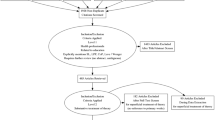Abstract
Learning how to ‘think like doctors’ can be difficult for undergraduate medical students in their early clinical years. Our model of collaborative Integrated Case Learning (ICL) and simulated clinical reasoning aims to address these issues. Taking a socio-cultural perspective, this study investigates the reflective learning interactions and practices of clinical thinking that emerged in the ICL environment. We also explore how third year medical students perceived their ICL experiences in relation to the clinical situations encountered in the hospital setting. The context for the inquiry is a rural Clinical School in North West Victoria, Australia. We used a qualitative case study methodology following eight third-year medical students over an academic year. Individual and group interviews were conducted, together with observations and document/artefact analysis. Data was analysed using content and narrative methods. The ICL program was well received. Findings suggest that the group-based, simulated clinical reasoning process appears to help undergraduate medical students to rehearse, articulate and question their clinical decision-making pathways. We argue that the ICL process offers a professionally challenging, but supportive group learning ‘space’ for students to practise what it might mean to ‘think’, ‘talk’ and ‘perform’ like doctors in real settings. The ICL environment also appears to create a connective bridge between the ‘classroom’ and clinical practice.


Similar content being viewed by others
References
Ajjawi, R., & Higgs, J. (2008). Learning to reason: A journey of professional socialisation. Advances in Health Sciences Education, 13, 133–150.
Beckett, D., & Gough, J. (2004). Perceptions of professional identity: A story from paediatrics. Studies in Continuing Education, 26(2), 195–208.
Beckett, D., & Hager, P. (2002). Life, work and learning: Practice in postmodernity. London: Routledge.
Billett, S. (2003). Vocational curriculum and pedagogy: An activity theory perspective. European Educational Research Journal, 2(1), 6–21.
Bleakley, A. (2006). Broadening conceptions of learning in medical education: The message from teamwork. Medical Education, 40, 150–157.
Bowen, J. (2006). Educational strategies to promote clinical diagnostic reasoning. New England Journal of Medicine, 355, 2217–2225.
Cahill, H. (2005). Profound learning: Drama partnerships between adolescents and tertiary students of medicine and education. NJ(Drama Australia Journal), 29(2), 59–71.
Carter, M., & Robinson, S. (2001). A narrative approach to the clinical reasoning process in pediatric intensive care: The story of Mathew. Journal of Medical Humanities, 22(3), 173–194.
Dolmans, D., De Grave, W., Wolfhagen, I., & Van Der Vleuten, C. (2005). Problem-based learning: Future challenges for educational practice and research. Medical Education, 39, 732–741.
Elliott, J. (2005). Using narrative in social research: Qualitative and quantitative approaches. London: Sage
Epstein, R. (2007). Assessment in medical education. New England Journal of Medical Education, 356(4), 387–396.
Ericsson, K., Krampe, R., & Tesch-Romer, C. (1993). The role of deliberative practice in the acquisition of expert performance. Psychological Review, 100, 363–406.
Eva, K. W. (2004). What every teacher needs to know about clinical reasoning. Medical Education, 39, 98–106.
Ewick, P., & Silbey, S. (2003). Narrating social structure: Stories of resistance to legal authority. American Journal of Sociology, 108, 1328–1372.
Griffiths, T., & Guile, D. (2003). A connective model of learning: Implications for work process knowledge. European Educational Research Journal, 2(1), 56–73.
Groopman, J. (2007). How doctors think. Boston: Houghton Mifflin.
Harden, R. M., Crosby, J., Davis, M. H., Howie, P. W., & Struthers, A. D. (2000). Task-based learning: The answer to integration and problem-based learning in the clinical years. Medical Education, 34, 391–397.
Hartley, J. (2004). Case study research. In C. Cassell & G. Symon (Eds.), Essential guide to qualitative methods in organisational research (pp. 323–333). London: Sage.
Higgs, J., & Jones, M. (2008). Clinical decision making and multiple problem spaces. In J. Higgs, M. A. Jones, S. Loftus, & N. Christenson (Eds.), Clinical reasoning in the health professions (pp. 3–17). Amsterdam: Elsevier.
Jacobsen, T., Baerheim, A., Lepp, M., & Scei, E. (2006). Analysis of role-play in medical communication training using a theatrical device the forth wall. BMC Medical Education, 6(51). Retrieved June 20, 2007 from http://www.biomedicalcentral.com/1472-6920/6/51.
Kaufman, D. M. (2003). ABC of learning and teaching in medicine: Applying educational theory in practice. BMJ, 326, 312–316.
Kneebone, R., Kidd, J., Nestel, D., Asval, S., Paraskeva, P., & Darzi, A. (2002). An innovative model for teaching and learning clinical procedures. Medical Education, 36, 628–634.
Kneebone, R., & Nestel, D. (2005). Learning clinical skills: The place of simulation and feedback. The Clinical Teacher, 2(2), 86–90.
Lave, J., & Wenger, E. (1991). Situated learning: Legitimate peripheral participation. Cambridge: Cambridge University Press.
Merriam, S. (1998). Qualitative research and case study application in education: Revised and expanded from case study research in education (2nd ed.). San Francisco: Jossey-Bass.
Mishler, E. (1986). Research interviewing: Context and narrative. Cambridge: Harvard University Press.
Montgomery, K. (2006). How doctors think: Clinical judgement and the practice of medicine. Oxford: New York.
Riessman, C. (2008). Narrative methods for the human sciences. Los Angeles: Sage.
Rolfe, I., & Sanson-Fisher, R. (2002). Translating learning principles into practice: A new strategy for learning clinical skills. Medical Education, 36, 345–352.
Shapiro, J., & Hunt, L. (2003). All the world’s a stage: The use of theatrical performance in medical education. Medical Education, 37, 922–927.
Stake, R. (2005). Qualitative case studies. In N. K. Denzin & Y. Lincoln (Eds.), The sage handbook of qualitative research (3rd ed., pp. 443–466). Thousand Oaks, CA: Sage.
Stern, S., Cifu, A., & Altkorn, D. (2006). Symptom to diagnosis: An evidence-based guide. New York: McGraw Hill.
Vermunt, J., & Verloop, N. (1999). Congruence and friction between learning and teaching. Learning and Instruction, 9, 257–280.
Vygotsky, L. S. (1978). Mind and society: The development of higher psychological processes. Cambridge, MA: Harvard University Press.
Acknowledgements
Our thanks to the medical students who participated in this study and to Pam Harvey and Professor Debra Nestel for their advice in preparing this paper.
Author information
Authors and Affiliations
Corresponding author
Rights and permissions
About this article
Cite this article
Radomski, N., Russell, J. Integrated Case Learning: teaching clinical reasoning. Adv in Health Sci Educ 15, 251–264 (2010). https://doi.org/10.1007/s10459-009-9195-x
Received:
Accepted:
Published:
Issue Date:
DOI: https://doi.org/10.1007/s10459-009-9195-x




